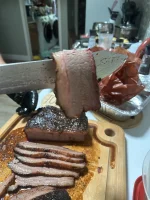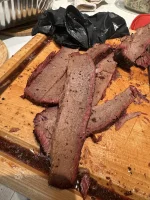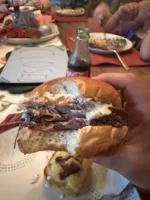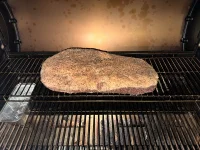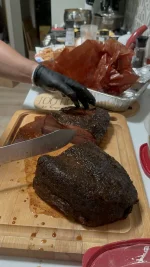akhugelier1
New member
- Joined
- May 20, 2024
- Messages
- 11
- Reaction score
- 17
- Location
- Oakland, MI
- Grill
- Searwood 600XL, Kettle 22”, Genesis 410
Ok, so this is one cook I’ve been dying to try ever since getting the Searwood XL about a month ago. I’ve always stuck to my stick burner, though have tried a few on the Smokey Mountain and my kamado…none could touch my offset. So full disclosure, I went into this with low expectations, but hopes that I could produce a passable brisket without staying up all night. Spoiler alert, the Searwood XL completely changed my mind on pellets for legit BBQ!
Here’s the deets:
I bought a 15lb. Angus brisket and prepped it the same way I would on my offset. Trim well, season with salt, Lawry’s seasoned salt, garlic powder, and black pepper. I let it sit in the fridge for roughly 10 hours, no marinades, binders, or injections. To make it as close to my offset method as possible (and to remove as many variables as possible), I chose to add a small water pan to the Searwood before the cook. I used Lumberjack pellets with a 50/50 mix of Cherry and Competition Blend. I normally use cherry and a bit of post oak and/or pecan, so this felt like a good mix. Put the brisket on the top rack too. I chose to smoke on the Smoke Boost setting for an hour, then moved to 220 for the remainder of the cook until wrap time. I cooked until it stalled heavily around 11 hours in at 175 degrees, then wrapped in butcher’s paper and then again in foil. I normally add tallow when I wrap, but I ran out and had to settle for a few pats of butter. I pulled at about 15 hours total cook time at 201 when the probe went in with no resistance, then put on the cutting board covered with a towel to rest for an hour.
The good:
As you can see from the pics, this thing was super juicy, tender, and it had a GREAT smoke profile with a thick smoke ring (doesn’t seem to allow me to add a short video). It completely surprised me with how good it tasted. I will absolutely be doing brisket again on the Searwood, and it may be my go-to for a single brisket type of thing.
What I’d change:
I had no idea this would be a 15 hour cook, as my offset would’ve finished that brisket in 10 hours at that temperature (and I have no idea why, so maybe some thoughts on the time difference despite the same cooking temp?). That said, I would’ve started earlier at around 8 or 9 pm so I could do my normal 4 hour rest instead of 1 hour rest on the counter…but there’s always a next time. Outside of that, I really can’t complain here. An absolutely awesome brisket, better than most BBQ joints I’ve been to here in MI. Don’t let your pellet grill fool you, that Searwood puts out legit BBQ flavor with none of the hassle of a standard stick burner!
Here’s the deets:
I bought a 15lb. Angus brisket and prepped it the same way I would on my offset. Trim well, season with salt, Lawry’s seasoned salt, garlic powder, and black pepper. I let it sit in the fridge for roughly 10 hours, no marinades, binders, or injections. To make it as close to my offset method as possible (and to remove as many variables as possible), I chose to add a small water pan to the Searwood before the cook. I used Lumberjack pellets with a 50/50 mix of Cherry and Competition Blend. I normally use cherry and a bit of post oak and/or pecan, so this felt like a good mix. Put the brisket on the top rack too. I chose to smoke on the Smoke Boost setting for an hour, then moved to 220 for the remainder of the cook until wrap time. I cooked until it stalled heavily around 11 hours in at 175 degrees, then wrapped in butcher’s paper and then again in foil. I normally add tallow when I wrap, but I ran out and had to settle for a few pats of butter. I pulled at about 15 hours total cook time at 201 when the probe went in with no resistance, then put on the cutting board covered with a towel to rest for an hour.
The good:
As you can see from the pics, this thing was super juicy, tender, and it had a GREAT smoke profile with a thick smoke ring (doesn’t seem to allow me to add a short video). It completely surprised me with how good it tasted. I will absolutely be doing brisket again on the Searwood, and it may be my go-to for a single brisket type of thing.
What I’d change:
I had no idea this would be a 15 hour cook, as my offset would’ve finished that brisket in 10 hours at that temperature (and I have no idea why, so maybe some thoughts on the time difference despite the same cooking temp?). That said, I would’ve started earlier at around 8 or 9 pm so I could do my normal 4 hour rest instead of 1 hour rest on the counter…but there’s always a next time. Outside of that, I really can’t complain here. An absolutely awesome brisket, better than most BBQ joints I’ve been to here in MI. Don’t let your pellet grill fool you, that Searwood puts out legit BBQ flavor with none of the hassle of a standard stick burner!

